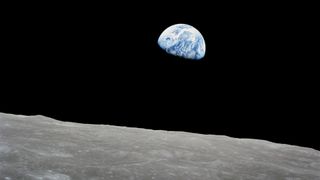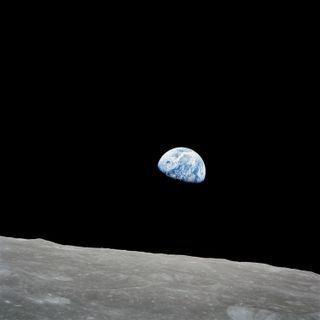Space photo of the week: 'Earthrise,' the Christmas Eve image that changed the world
Snapped from lunar orbit in 1968 by NASA astronaut Bill Anders, who died this week at age 90, 'Earthrise' is perhaps the most iconic image of our planet ever taken.

What it is: "Earthrise," an iconic view of Earth above the moon's horizon
Where it is: The moon, as seen from orbit aboard the Apollo 8 spacecraft
When it was taken: Christmas Eve, 1968
Why it's so special: One of the most profound photographs ever taken, "Earthrise," has been credited as a driving force of the environmental movement. The image was captured by Bill Anders, lunar module pilot for NASA's Apollo 8 mission, the first lunar orbit mission, on Dec. 24, 1968.
NASA reshared the image this month in memory of Anders, who died in a plane crash on June 7 in Washington's San Juan Islands at the age of 90.
His image, taken using a 70mm Hasselblad still camera with a 250mm telephoto lens, shows Earth around 5 degrees above the lunar horizon. The image of a half-lit Earth shows Antarctica to the upper left and, close to the sunset line, North and South America mostly under clouds.
The original photo was actually taken with Earth on the left of the moon, but the image people remember is the view rotated 90 degrees such that Earth appears to be rising above the horizon. Earth doesn't rise in the way the sun and moon appear to from Earth; the only way to see Earth appear to rise from the moon is from lunar orbit.
Sign up for the Live Science daily newsletter now
Get the world’s most fascinating discoveries delivered straight to your inbox.
The image was taken at around 10:30 a.m. Central time, during the fourth of 10 orbits completed by Apollo 8's command module, but it was improvised, with Anders asking his fellow astronauts Frank Borman and Jim Lovell for a camera with color film.

"Oh my God, look at that picture over there! There's the Earth coming up. Wow, is that pretty!" Anders said. "You got a color film, Jim? Hand me a roll of color, quick, would you? Hurry! Quick!"
Lovell found the roll of color film, and after a few attempts through a couple of different windows, Anders got the shot at several different settings. It's cataloged as image AS08-14-2383 in the Lunar and Planetary Institute's archive of the mission.
The image was fitting for the mission because the three astronauts were the first humans to escape the gravitational pull of Earth and the first to orbit the moon. Anders was also a backup pilot for Apollo 11, the first mission to land humans on the moon, the following year.
"Bill Anders gave to humanity among the deepest gifts an explorer and an astronaut can give," NASA Administrator Bill Nelson said in a statement. "Along with the Apollo 8 crew, Bill was the first to show us, through looking back at the Earth from the threshold of the Moon, that stunning image — the first of its kind — of the Earth suspended in space, illuminated in light and hidden in darkness: the Earthrise."
In 2018, the 25-mile-wide (40 kilometers) lunar impact crater on the far side of the moon in the foreground of the famous image was renamed "Anders' Earthrise."
Jamie Carter is a freelance journalist and regular Live Science contributor based in Cardiff, U.K. He is the author of A Stargazing Program For Beginners and lectures on astronomy and the natural world. Jamie regularly writes for Space.com, TechRadar.com, Forbes Science, BBC Wildlife magazine and Scientific American, and many others. He edits WhenIsTheNextEclipse.com.
Most Popular


